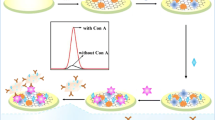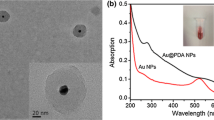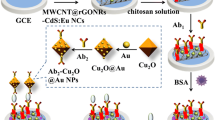Abstract
A highly efficient ratiometric electrochemiluminescence (ECL) immunoassay was explored by bidirectionally regulating the ECL intensity of two luminophors. The immunoassay was conducted in a split-type mode consisting of an ECL detection procedure and a sandwich immunoreaction. The ECL detection was executed using a dual-disk glassy carbon electrode modified with two potential-resolved luminophors (g-C3N4-Ag and Ru-MOF-Ag nanocomposites), and the sandwich immunoreaction using glucose oxidase (GOx)-modified SiO2 nanospheres as labels was carried out in a 96-well plate. The Ag nanoparticles (NPs) acted as bifunctional units both for triggering the resonance energy transfer (RET) with g-C3N4 and for accelerating the electron transfer rate of the Ru-MOF-Ag ECL reaction. When the H2O2 catalyzed by GOx in the 96-well plate was transferred to the dual-disk glass carbon electrode, the doped Ag NPs in the two luminophors could be etched, thus destroying the RET between C3N4 and the accelerated reaction to Ru-MOF, resulting in an opposite trend in the ECL signal outputted from the dual disks. Using the ratio of the two signals for quantification, the constructed immunosensor for a model target, i.e. myoglobin, exhibited a low detection limit of 4.7 × 10–14 g/mL. The ingenious combination of ECL ratiometry, bifunctional Ag NPs, and a split-type strategy effectively reduces environmental and human errors, offering a more precise and sensitive analysis for complex samples.
Graphical Abstract







Similar content being viewed by others
References
Wang J, Haghighatbin MA, Shen W, Mi L, Cui H. Metal ion-mediated potential-resolved ratiometric electrochemiluminescence bioassay for efficient determination of miR-133a in early diagnosis of acute myocardial infarction. Anal Chem. 2020;92(10):7062–70. https://doi.org/10.1021/acs.analchem.0c00377.
Fan ZQ, Yao B, Ding YD, Xu D, Zhao J, Zhang K. Rational engineering the DNA tetrahedrons of dual wavelength ratiometric electrochemiluminescence biosensor for high efficient detection of SARS-CoV-2 RdRp gene by using entropy-driven and bipedal DNA walker amplification strategy. Chem Eng J. 2022;427:131686. https://doi.org/10.1016/j.cej.2021.131686.
Gong CB, Fan YF, Zhao HM. Recent advances and perspectives of enzyme-based optical biosensing for organophosphorus pesticides detection. Talanta. 2022;240:123145.
Huo XL, Lu HJ, Xu JJ, Zhou H, Chen HY. Recent advances of ratiometric electrochemiluminescence biosensors. J Mater Chem B. 2019;7(42):6469–75. https://doi.org/10.1039/C9TB01823A.
Li M, Yuan Z, Zhang L, Zhou H, Shen Q. Dual-potential ratiometric electrochemiluminescence microRNA bioassay based on inner reference probe and catalytic hairpin assembly. Sens Actuators B-Chem. 2022;373:132747. https://doi.org/10.1016/j.snb.2022.132747.
Wang YL, Liu FR, Cao JT, Ren SW, Liu YM. Spatial-resolved dual-signal-output electrochemiluminescent ratiometric strategy for accurate and sensitive immunoassay. Biosens Bioelectron. 2018;102:525–30. https://doi.org/10.1016/j.bios.2017.11.067.
Liu FR, Cao JT, Wang YL, Fu XL, Ren SW, Liu YM. A spatial-resolved electrochemiluminescence aptasensor for carcinoembryonic antigen detection in a double-check mode. Sens Actuators B-Chem. 2018;276:173–9. https://doi.org/10.1016/j.snb.2018.08.082.
Li B, Li Y, Li C, Yang J, Liu D, Wang H, Xu R, Zhang Y, Wei Q. An ultrasensitive split-type electrochemical immunosensor based on controlled-release strategy for detection of CA19-9. Biosens Bioelectron. 2023;227:115180. https://doi.org/10.1016/j.bios.2023.115180.
Zhang N, Leng D, Wang Y, Ru Z, Zhao G, Li Y, Zhang DP, Wei Q. Split-type photoelectrochemical/visual sensing platform based on SnO2/MgIn2S4/Zn0.1Cd0.9S composites and Au@Fe3O4 nanoparticles for ultrasensitive detection of neuron specific enolase. Anal Chem. 2022;94(45):15873–8. https://doi.org/10.1021/acs.analchem.2c03942.
Cao JT, Fu XL, Zhao LZ, Ma SH, Liu YM. Highly efficient resonance energy transfer in g-C3N4-Ag nanostructure: Proof-of-concept toward sensitive split-type electrochemiluminescence immunoassay. Sens Actuators B-Chem. 2020;311:127926. https://doi.org/10.1016/j.snb.2020.127926.
Cao JT, Fu YZ, Wang YL, Zhang HD, Liu XM, Ren SW, Liu YM. Liposome-assisted chemical redox cycling strategy for advanced signal amplification: A proof-of-concept toward sensitive electrochemiluminescence immunoassay. Biosens Bioelectron. 2022;214:114514. https://doi.org/10.1016/j.bios.2022.114514.
Huang Z, Yu S, Jian M, Weng Z, Deng H, Peng H, Chen W. Ultrasensitive glutathione-mediated facile split-type electrochemiluminescence nanoswitch sensing platform. Anal Chem. 2022;94(4):2341–7. https://doi.org/10.1021/acs.analchem.1c05198.
He Y, Hu FX, Zhao JW, Yang G, Zhang Y, Chen S, Yuan R. Bifunctional moderator-powered ratiometric electrochemiluminescence enzymatic biosensors for detecting organophosphorus pesticides based on dual-signal combined nanoprobes. Anal Chem. 2021;93(25):8783–90. https://doi.org/10.1021/acs.analchem.1c00179.
Jain S, Mehata MS. Medicinal plant leaf extract and pure flavonoid mediated green synthesis of silver nanoparticles and their enhanced antibacterial property. Sci Rep. 2017;7:15867. https://doi.org/10.1038/s41598-017-15724-8.
Roy P, Das B, Mohanty A, Mohapatra S. Green synthesis of silver nanoparticles using Azadirachta indica leaf extract and its antimicrobial study. Appl Nanosci. 2017;7:843–50. https://doi.org/10.1007/s13204-017-0621-8.
Zou R, Xie R, Peng Y, Guan W, Lin Y, Lu C. Ag-O-Co interface modulation-amplified luminol cathodic electrogenerated chemiluminescence. Anal Chem. 2022;94(11):4813–20. https://doi.org/10.1021/acs.analchem.2c00050.
Du X, Jiang D, Liu Q, Qian J, Mao H, Wang K. Enhanced electrochemiluminescence sensing platform using nitrogen-doped graphene as a novel two-dimensional mat of silver nanoparticles. Talanta. 2015;132:146–9. https://doi.org/10.1016/j.talanta.2014.08.065.
Yang F, Yang F, Tu TT, Liao N, Chai YQ, Yuan R, Zhuo Y. A synergistic promotion strategy remarkably accelerated electrochemiluminescence of SnO2 QDs for MicroRNA detection using 3D DNA walker amplification. Biosens Bioelectron. 2021;173:112820. https://doi.org/10.1016/j.bios.2020.112820.
Jiao M, Jie GF, Tan L, Niu S. Ag NPs-3D nanostructure enhanced electrochemiluminescence of CdSe quantum dot coupled with strand displacement amplification for sensitive biosensing of DNA. Anal Chim Acta. 2017;983:166–72. https://doi.org/10.1016/j.aca.2017.06.022.
Chu Y, Han T, Deng A, Li L, Zhu JJ. Resonance energy transfer in electrochemiluminescent and photoelectrochemical bioanalysis. TrAC Trends Anal Chem. 2020;123:115745. https://doi.org/10.1016/j.trac.2019.115745.
Wang YZ, Hao N, Feng QM, Shi HW, Xu JJ, Chen HY. A ratiometric electrochemiluminescence detection for cancer cells using g-C3N4 nanosheets and Ag-PAMAM-luminol nanocomposites. Biosens Bioelectron. 2016;77:76–82. https://doi.org/10.1016/j.bios.2015.08.057.
Ai ZJ, Zhao M, Han DB, Chen K, Xiong D, Tang H. An, “on-off” electrochemiluminescence immunosensor for PIVKA-II detection based on the dual quenching of CeO2-Au-g-C3N4 hybrids by Ag nanocubes-VB2. Biosens Bioelectron. 2021;179:113059. https://doi.org/10.1016/j.bios.2021.113059.
Gao Y, Zhang X, Yan J, Guan Q, Xing Y, Song W. Split-type cascaded silver etching for “on-super off” PEC-EC dual-mode immunosensing of α-SynO. Sens Actuators B-Chem. 2022;358:131449. https://doi.org/10.1016/j.snb.2022.131449.
Ribeiro JA, Pereira CM, Silva AF, Sales MGF. Electrochemical detection of cardiac biomarker myoglobin using polyphenol as imprinted polymer receptor. Anal Chim Acta. 2017;981:41–52. https://doi.org/10.1016/j.aca.2017.05.017.
Chen L, Huang D, Ren S, Dong T, Chi Y, Chen G. Preparation of graphite-like carbon nitride nanoflake film with strong fluorescent and electrochemiluminescent activity. Nanoscale. 2013;5(1):225–30. https://doi.org/10.1039/C2NR32248J.
Zhang XD, Xie X, Wang H, Zhang J, Pan B, Xie Y. Enhanced photoresponsive ultrathin graphitic-phase C3N4 nanosheets for bioimaging. J Am Chem Soc. 2013;135(1):18–21. https://doi.org/10.1021/ja308249k.
Zou J, Mao D, Wee ATS, Jiang J. Micro/nano-structured ultrathin g-C3N4/Ag nanoparticle hybrids as efficient electrochemical biosensors for l-tyrosine. Appl Surf Sci. 2019;467:608–18. https://doi.org/10.1016/j.apsusc.2018.10.187.
Bai WQ, Cui AP, Liu MZ, Qiao X, Li Y, Wang T. Signal-off electrogenerated chemiluminescence biosensing platform based on the quenching effect between ferrocene and Ru(bpy)32+-functionalized metal-organic frameworks for the detection of methylated RNA. Anal Chem. 2019;91(18):11840–7. https://doi.org/10.1021/acs.analchem.9b02569.
Cao JT, Wang B, Dong YX, Wang Q, Ren SW, Liu YM, Zhao WW. Photogenerated hole-induced chemical redox cycling on Bi2S3/Bi2Sn2O7 heterojunction: toward general amplified split-type photoelectrochemical immunoassay. ACS Sensors. 2018;3(6):1087–92. https://doi.org/10.1021/acssensors.8b00332.
Wen T, Qu F, Li NB, Luo HW. Polyethyleneimine-capped silver nanoclusters as a fluorescence probe for sensitive detection of hydrogen peroxide and glucose. Anal Chim Acta. 2012;749:56–62. https://doi.org/10.1016/j.aca.2012.08.048.
Contado C, Argazzi R, Amendola V. Sedimentation field flow fractionation and optical absorption spectroscopy for a quantitative size characterization of silver nanoparticles. J Chromatogr A. 2016;1471:178–85. https://doi.org/10.1016/j.chroma.2016.10.026.
Wang CY, Huang HJ. Flow injection analysis of glucose based on its inhibition of electrochemiluminescence in a Ru(bpy)32+–tripropylamine system. Anal Chim Acta. 2003;498:61–8. https://doi.org/10.1016/j.aca.2003.08.064.
Zheng H, Zu Y. Emission of tris(2,2‘-bipyridine)ruthenium(II) by coreactant electrogenerated chemiluminescence: from O2-insensitive to highly O2-sensitive. J Phys Chem B. 2005;109:12049–53. https://doi.org/10.1021/jp050350d.
Funding
The study received funding from the National Natural Science Foundation of China (Grant No. 22304146, 21874115, and 21675136), Program for Innovative Research Team (in Science and Technology) in the University of Henan Province (24IRTSTHN004), the Natural Science Foundation of Henan Province (232300420389), Key Scientific Research Project of Higher Education Institutions in Henan Province (24A150037, 22A150022), Shandong Key Laboratory of Biochemical Analysis (SKLBA2205), and the Nanhu Scholars Program for Young Scholars of Xinyang Normal University (XYNU).
Author information
Authors and Affiliations
Contributions
Yu-Ling Wang: Methodology, Investigation, Supervision, Project administration, Writing—modification. Xiang-Mei Liu: Conceptualization, Methodology, Investigation, Writing—original draft. Shu-Wei Ren: Validation. Jun-Tao Cao: Conceptualization, Methodology, Supervision, Project administration, Resource provision, Writing—original draft, Writing—review & editing. Yan-Ming Liu: Conceptualization, Methodology, Supervision, Project administration, Resource provision, Writing—original draft, Writing—review & editing.
Corresponding authors
Ethics declarations
Ethics approval
Samples of human serum were obtained from the Affiliated Hospital of Xinyang Normal University with the approval of its ethics committee (XFEC-2023–029).
Consent to participate
The human serum samples used in this study were collected with the consent of the volunteers. The study was approved by the experimental ethics committee of Xinyang Normal University and its affiliated hospital.
Conflict of interest
The authors declare no competing interests.
Additional information
Publisher's Note
Springer Nature remains neutral with regard to jurisdictional claims in published maps and institutional affiliations.
Published in the topical collection Emerging Trends in Electrochemical Analysis with guest editors Sabine Szunerits, Wei Wang, and Adam T. Woolley.
Supplementary Information
Below is the link to the electronic supplementary material.
Rights and permissions
Springer Nature or its licensor (e.g. a society or other partner) holds exclusive rights to this article under a publishing agreement with the author(s) or other rightsholder(s); author self-archiving of the accepted manuscript version of this article is solely governed by the terms of such publishing agreement and applicable law.
About this article
Cite this article
Wang, YL., Liu, XM., Ren, SW. et al. Etching of Ag nanoparticles triggered bidirectional regulation for electrochemiluminescence ratiometric immunoassay. Anal Bioanal Chem (2024). https://doi.org/10.1007/s00216-024-05277-x
Received:
Revised:
Accepted:
Published:
DOI: https://doi.org/10.1007/s00216-024-05277-x




